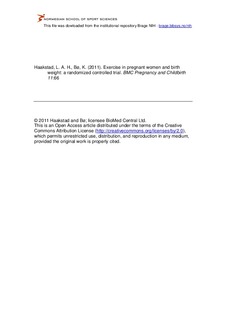| dc.contributor.author | Haakstad, Lene Annette Hagen | |
| dc.contributor.author | Bø, Kari | |
| dc.date.accessioned | 2011-11-09T11:31:33Z | |
| dc.date.available | 2011-11-09T11:31:33Z | |
| dc.date.issued | 2011-09-30 | |
| dc.identifier | Seksjon for idrettsmedisinske fag / Department of Sports Medicine | |
| dc.identifier.citation | BMC Pregnancy and Childbirth. 2011. 11:66 | no_NO |
| dc.identifier.issn | 1471-2393 | |
| dc.identifier.uri | http://hdl.handle.net/11250/170701 | |
| dc.description | © 2011 Haakstad and Bø; licensee BioMed Central Ltd.
This is an Open Access article distributed under the terms of the Creative
Commons Attribution License (http://creativecommons.org/licenses/by/2.0),
which permits unrestricted use, distribution, and reproduction in any medium,
provided the original work is properly cited. | no_NO |
| dc.description.abstract | Background: Birth weight plays an important role in infant mortality and morbidity, childhood development, and
adult health. To date there are contradictory results regarding the role of physical activity on birth weight. In
addition, it is questioned whether exercise during second and third trimesters of pregnancy might affect
gestational age and increase the risk of preterm delivery. Hence, the purpose of this study was to examine the
effect of a supervised exercise-program on birth weight, gestational age at delivery and Apgar-score.
Methods: Sedentary, nulliparous pregnant women (N = 105), mean age 30.7 ± 4.0 years, pre-pregnancy BMI 23.8 ±
4.3 were randomized to either an exercise group (EG, n = 52) or a control group (CG, n = 53). The exercise program
consisted of supervised aerobic dance and strength training for 60 minutes, twice per week for a minimum of 12
weeks, with an additional 30 minutes of self-imposed physical activity on the non-supervised week-days.
Results: There was no statistically significant difference between groups in mean birth weight, low birth weight
(< 2500 g) or macrosomia (≥ 4000 g). Per protocol analyses showed higher Apgar score (1 min) in the EG compared
with the CG (p = 0.02). No difference was seen in length of gestation.
Conclusion: Aerobic-dance exercise was not associated with reduction in birth weight, preterm birth rate or
neonatal well-being.
Trial Registration: ClinicalTrials.gov: NCT00617149 | no_NO |
| dc.language.iso | eng | no_NO |
| dc.publisher | BioMed Central | no_NO |
| dc.title | Exercise in pregnant women and birth weight: a randomized controlled trial | no_NO |
| dc.type | Journal article | no_NO |
| dc.type | Peer reviewed | no_NO |
| dc.subject.nsi | VDP::Medical disciplines: 700::Clinical medical disciplines: 750 | no_NO |
| dc.source.volume | 11 | no_NO |
| dc.source.journal | BMC Pregnancy and Childbirth | no_NO |
